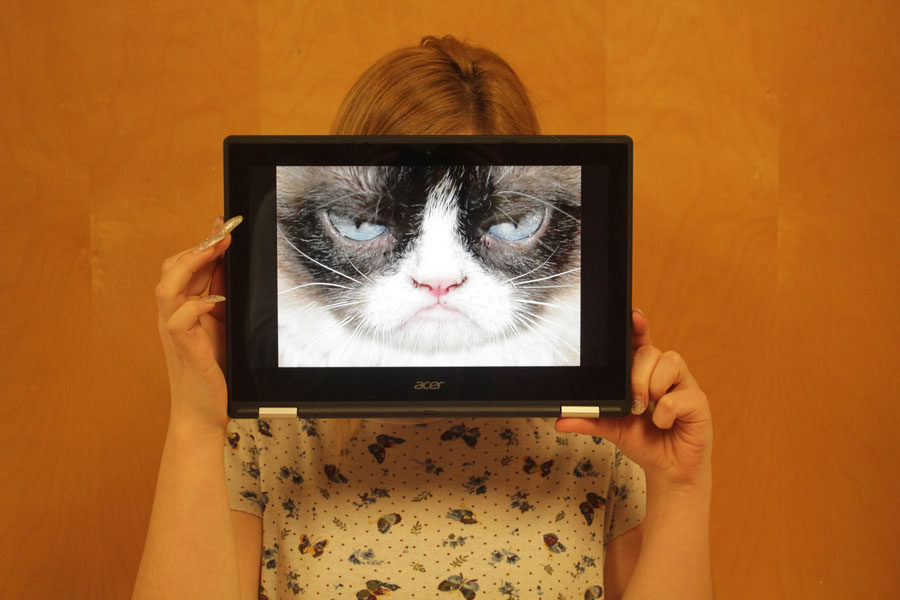FurryMania!
March 10, 2017
Instagram: A mobile photo sharing application that allows users to share pictures and videos to an extensive number of people; a platform that people use in creative ways to generate sales and build brand loyalty, even allowing viewers to choose an adventure with tagged images.
We’re all used to these uses for Instagram. But recently, people have thought of perhaps the most ingenious way to not only gather a fan base, but make money doing so: making pets famous.
Chloe, the Instagram sensation, has over 115,000 followers. She loves traveling, fashion and photo shoots, Loni Edwards explained. Edwards owns Chloe, a khaki-colored, miniature French bulldog who is one of the most elite and recognizable animals in social media.
Take the words of Sarah Jacobsson, a writer for “PCWorld,” who retells an event that took place at a retail store. “His name is Blanka,” she said to the sales associate at Free People as her ten-pound French bulldog snorted his way across the countertop. “I might be biased, but isn’t he adorable?”
Oh my god,” said the girl. “Does he have an Instagram account yet?”
The general rule of thumb, according to Corinne Purtill writing on the website Quartz, in the “highly profitable, deeply adorable, and emotionally fraught world of famous animals” is $2,000 and up per gig upon breaking the 100,000-follower mark, not to mention product lines, endorsements and guest appearances.
Many of the pet pictures are highly stylized: no litter boxes in sight, with perfect lighting. Yeah, that’s right, even animals on social media live better than you do.
Take Pumpkin The Raccoon, for example, who has 1,000,000 followers on Instagram, where in one of her frivolous yet astonishing pictures she is feasting on some “#guava” and “#homegrownjam” from what appears to be luxurious China.
As might be expected of these people, some often ask themselves, Do I love my pet too much? And while many may argue that there is no such thing, here are some signs that they indeed do.
For starters, there’s nothing like the duo that carries their dog around everywhere they go, often shown in movies and in real life. But it is a completely different thing to carry them when they are not present. And while many might believe that a tattoo of their pet is a great way to advertise their love, a life-size miniature French poodle tattooed across one’s back might make people comment at the pool.
Other signs include justifying the fact that a pet has just denied its owner’s affection. An example is the classic “They must just be tired.” Another sign — one that might only apply to a younger generation — is daydreaming about what it would be like to be on Adventure Time with their dog.
While it is unclear how far pet keeping goes back, a study published by Cell Press Nucleus, on Current Biology website, says that as early as 27,000 years ago, humankind tamed wolves and gradually domesticated them, although it is unclear if human clothing was placed on them, or if the pets were immortalized on the owner’s body.
Ever since, humans have had dogs around, while keeping a pet has become part of many cultures.
The amount of love that one shares with a pet may seem strange when one considers it is a costly business. Unlike human beings, who can expect their children to care for them years down the line, from an evolutionary standpoint it makes sense to care for them, according to Melissa Hogenboom writing for BBC.
But the same is not true for family pets, which offer nothing material in return. Yet many people keep them and consider them an integral part of their families.
While research has shown that keeping pets improves human health, other more recent research has shown the opposite is true. Melanie Greenberg, writing in “Psychology Today,” writes that pet ownership has often been tied to “pulse pressure, mean arterial pressure or risk of hypertension.”
Other theories suggest that pet keeping is a result of picking up on social cues from others. In other words, pet keeping is a trend that is continually reinforced by its own popularity. A study conducted by Harold Herzog of Western Carolina University essentially concluded, “We keep pets because other people do.”
But the extensive research that has been put into why humans keep pets — and even idolize them — can be difficult to grasp given the combination of factors involved, like the unconditional love many feel that only a dog can provide, or the thrill of seeing a photo of a pug in a wig.



Alejandro • Mar 14, 2017 at 1:22 pm
Agreed
Johnsson • Mar 14, 2017 at 1:21 pm
This piece is amazing, tell this young man to always keep writing, he has the traits of a president. I love reading about how animals are famous on social media. Definitely.